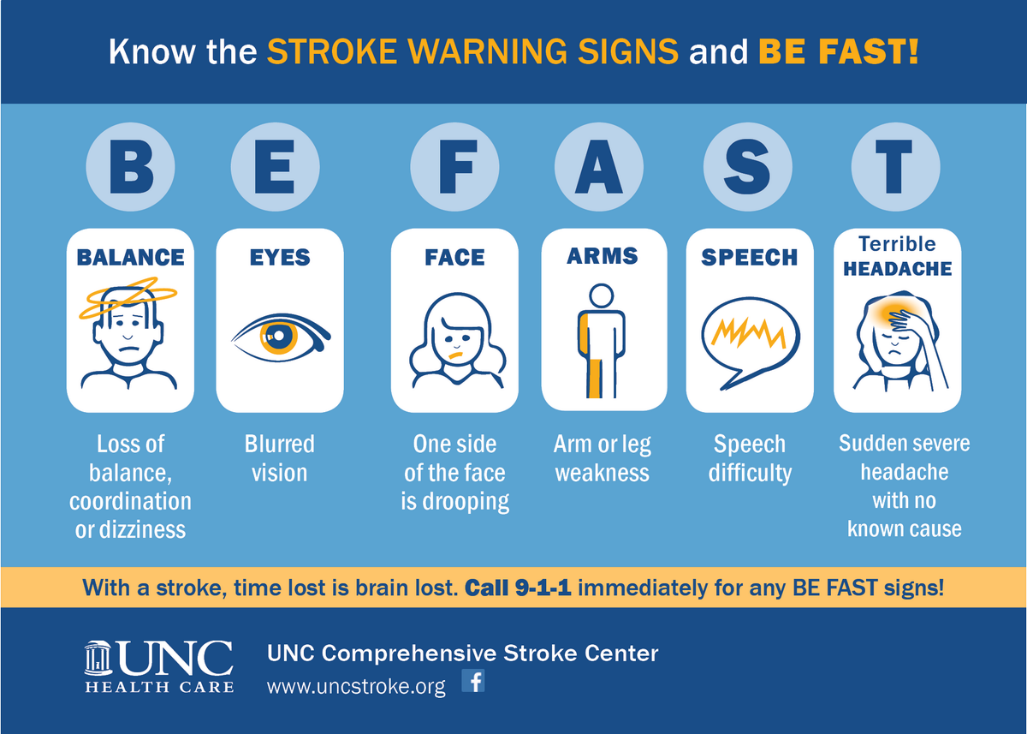Stroke Prevention
Stroke is the 4th leading cause of death overall here in North Carolina, and is the 3rd leading cause of death in women. It is also the number one leading cause of disability in adults. However, up to 80% of strokes can be prevented! Knowing what causes a stroke and how you can reduce your risk is the key to stroke prevention.
What Is A Stroke?
A stroke can occur when a blood vessel bursts or a blood clot blocks an artery. This causes brain cells to die and brain damage to occur which can affect movement, memory and speech and can lead to permanent disability.
Stroke Prevention
There are certain risk factors for stroke that we cannot control, like race or gender, but there are also plenty of risk factors that we do have control over. You can practice stroke prevention by changing lifestyle habits and medical conditions that put you at risk. Below are some factors that can affect your risk for stroke and what you can do to control them:
- Blood Pressure and Cholesterol – be aware of your target levels and get checked frequently to make sure you’re staying healthy
- Atrial Fibrillation (irregular heart beat) – can greatly increase your risk of stroke so it’s important that this gets diagnosed/treated by your doctor
- Alcohol and Tobacco – frequent smoking doubles your risk for stroke and alcohol consumption that exceeds two drinks per week can also increase your risk
- Diabetes – having diabetes can put you at risk for a number of different health problems that lead to stroke, so work with your doctor to keep this disease under control
- Exercise – if you are overweight it puts excess stress on your circulatory system, so exercise 4-5 days a week and work towards maintaining a healthy weight
- Diet – maintain a healthy and well-balanced diet that includes foods that are low in cholesterol, sodium, and saturated and trans fats
- Circulation Problems – poor circulation can lead to blocked arteries which cause stroke, so get tested for circulation problems and take proper medication if diagnosed
Stroke Risk Scorecard
Use this scorecard to evaluate your level of risk for stroke and talk to your doctor about any concerns.
BE-FAST
 Stroke prevention is important even after you start experiencing the first signs and symptoms of a stroke. There are certain medications and treatments that can prevent long-term effects of stroke if given within the first few hours of showing symptoms. Use BE-FAST to learn the signs of a stroke and to know when to get help:
Stroke prevention is important even after you start experiencing the first signs and symptoms of a stroke. There are certain medications and treatments that can prevent long-term effects of stroke if given within the first few hours of showing symptoms. Use BE-FAST to learn the signs of a stroke and to know when to get help:
Balance: Is there difficulty standing, walking or remaining steady when standing?
Eyes: Are there any “blind spots”, blurred, double vision or loss of sight?
Face: Does one side of the face droop or feel numb?
Arms: Is there any weakness or numbness in arms or legs?
Speech: Is speech slurred or strange, is there any difficulty understanding speech?
Time: Complaining of a terrible headache, “worst headache of my life”?
Call 911 immediately if you notice any of these symptoms!
If you or a loved one is experiencing stroke symptoms, call 9-1-1 to go to the closest emergency room. Johnston Health can safely assist you at our emergency departments in both Smithfield and Clayton. Measures are in place to ensure our patients can be cared for safely within our emergency departments.